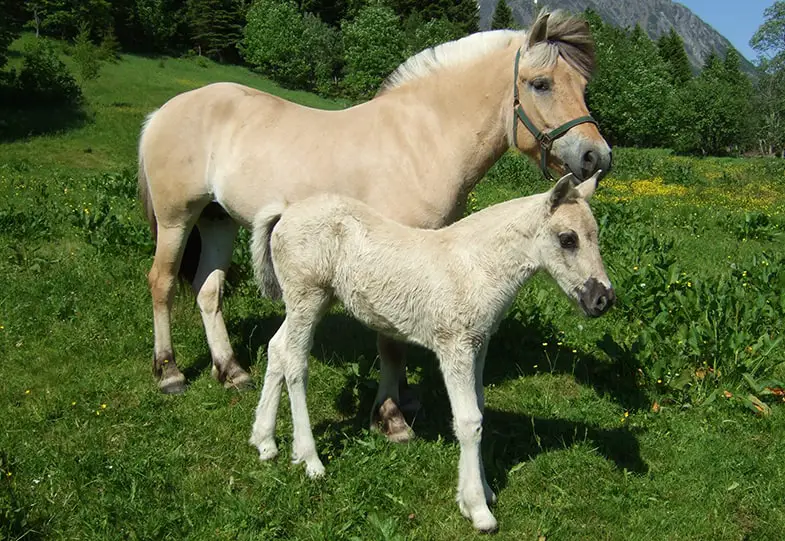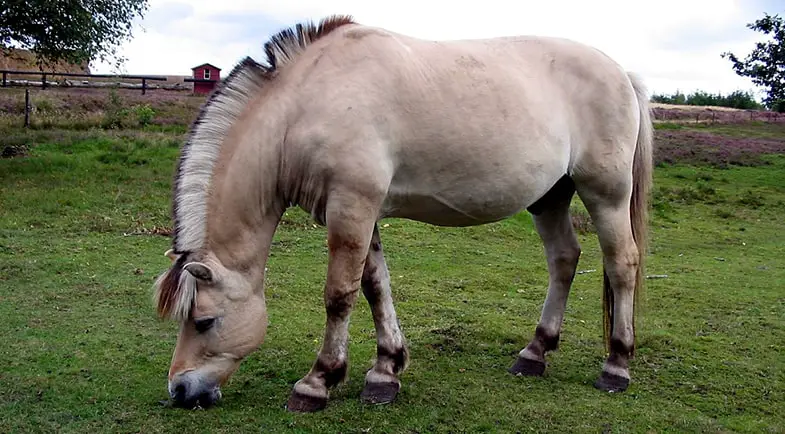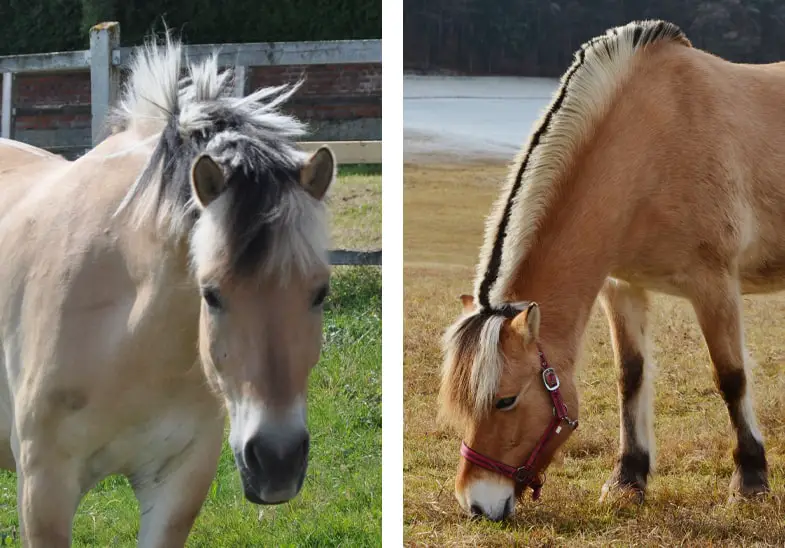With its striking mane, distinctive coloring, and stocky build there’s no mistaking the Norwegian Fjord but despite this, most people don’t know much about this plucky breed. Often wrongly described as a pony there’s a lot more to these horses than meets the eye. Read on to find out just how incredible the Norwegian Fjord really is.
Height: Most Norwegian Fjords stand between 14hh (56 inches) and 14.2hh (58 inches) although anything between 13.2hh (54 inches) and 15hh (60 inches) is allowed.
Color: All registered Norwegian Fjords are dun with primitive markings such as a dorsal stripe, mealy-colored muzzle, and zebra stripes on their legs.
Personality: The Norwegian Fjord is extremely people-oriented and eager to please. They have placid natures and don’t spook easily but are also highly intelligent and inquisitive.
Country of Origin: Norway
Registry: Norwegian Fjord Horse Registry
An ancient history
With a country being part of its name it’s easy to think that the Norwegian Fjord is a native of Norway but, while it’s called the Scandinavian country home for at least the past 2000 years, the breed itself is much older. As you’d expect for a horse that is thousands of years old its exact history is unknown but it does bare a striking resemblance to the prehistoric horses that adorned the walls of many Ice Age caves across Europe.
While there’s obviously no way of telling for sure if the Norwegian Fjord is descended from these Ice Age horses but what is known is that not only are they closely related to the Przewalski but they’ve been selectively bred for at least 2000 years. Recent archaeological excavations of Viking burial sites have discovered that the Vikings kept the breed pure and didn’t allow any other horses to influence the hardy Norwegian Fjord.
Viking war horses
Like its close cousin, the Icelandic Horse, the Norwegian Fjord has always had a close connection with the Vikings who loved their bravery and sturdy natures. Not only did they selectively breed them in order to create a superior breed but they also used them as war horses and would regularly ride them into battle.
They valued these plucky little horses so much that they were often buried alongside high-status Vikings.
Despite their size, they are draft horses
We often think of draft horses as being big, heavy animals that tower above our heads and pull beer drays or heavy agricultural equipment but don’t underestimate the power and strength of the Norwegian Fjord. While they may have been bred as an early war horse their incredible strength and sure-footedness meant that they were ideally suited to farm work.
Before the invention of tractors and other mechanized equipment they were a popular site on many farms and were regularly used to plow fields, and pull timber. During World War II they were used to transport goods and equipment over mountainous terrain that vehicles couldn’t reach.
Even today they can still be found working on remote farms in Norway and other Scandinavian countries.
A horse of many names
Like so many old breeds the Norwegian Fjord has been known by a variety of different names over the years. Once known as the Vestlandshest (which translates to mean West Country Horse) they were originally called Nordfjordhest (Norwegian for North Fjord Horse).
Sometimes referred to simply as the Fjord (pronounced fee-awd) their official title of Norwegian Fjord is a nod to their native habitat.
The Norwegian Fjord is a horse rather than a pony
You might be forgiven for thinking the Norwegian Fjord is a pony, after all, most are ‘pony sized’, but they are in fact horses. This is because their bone and muscle structure is more in line with that of a horse. That said though when it comes to metabolism they’re much closer to ponies which is why they find it all too easy to put weight on.
Crossbreeding nearly wiped the breed out
While the Vikings made a conscious effort to not allow other breeds to influence the Norwegian Fjord it was decided, in the 19th century, that the breed needed to be ‘improved’. A Døle (another Norwegian breed) stallion known as Rimfakse was used to increase the height of the breed and give it extra strength. While this seemed promising at first, within a few generations it was noticed that this was doing more harm than good.
The addition of the Døle meant that the Norwegian Fjord began to lose its identity and the qualities that made it such a good horse in the first place. It started to show unattractive coloring but more worryingly a lot of horses began to display fierce and fiery temperaments. After this, it was feared that the breed was in danger of being lost forever so it was decided to stop this crossbreeding program immediately.
All horses can trace back to just one stallion
In 1907, after the failed crossbreeding program, a decision was made to restore the breed to its former glory and reinstate the characteristics that made it so desirable in the first place. A number of stallions were used but the most notable of them, Njål, was so influential and sired a huge number of horses in his short 12 years that he is regarded as the founding father of the modern Norwegian Fjord. In fact all horses today can be traced directly back to him.
Mares are not very mare’ish
In years gone by many Norwegians didn’t have a huge amount of land so often lived directly above the stables where their horses were kept. While this might sound like a fantastic idea to many of us, in practice it’s not such a good idea if you’re trying to sleep and the horses are restless and making a lot of noise.
This is the main reason why Norwegian Fjords are generally quiet horses, with the stallions not being so excitable and the mares being less mare-like (at least compared to other breeds). This is just one example of why they’re perfect for children and make great family horses.
They only come in one color
One of the things that make the breed so distinctive is its coloring, while a lot of breeds can be found in a variety of different colors the Norwegian Fjord is famous for its dun coloring. While cream horses can occasionally be found only those with one of six shades of dun can be registered.
Brown dun (brunblakk)
A pale yellowy brown color that can range from cream to chestnut with horses having a cream or white mane and tail. Brown dun is, without doubt, the most common (and most popular) of all colors with around 90% of all horses being found in this shade of dun.
Red dun (rødblakk)
As you can imagine this is a reddy golden shade with the horse having either a white or cream-colored mane and tail.
White dun (ulsblakk)
Having a red base color with a cream gene, horses with this shade of dun have a cream body color with a lighter mane and tail.
Grey dun (grå)
Sometimes called silver dun, horses can range from a pale silver color to a slate shade with a lighter mane and tail.
Yellow dun (gulblakk)
The rarest of all shades of dun (not just within the Norwegian Fjord) but it’s essentially a red dun with the presence of a dilution gene that causes the red hairs to turn a light shade of cream. The mane and tail are even lighter still.
White (kvite)
I know I said that there were six shades of dun but white (or cream) isn’t dun and is actually a combination of dilutions genes that turns the horse’s hair creamy white in color. It also turned the eyes blue (instead of the brown shade they should be). While this color can be found in a few horses it’s classed as undesirable and horses displaying this aren’t allowed to be registered.
Primitive markings
As we’ve selectively bred horses over millennia many breeds have lost the primitive markings that they once had but the Norwegian Fjord certainly hasn’t and they are one of the things that give the breed its distinctive and eye-catching appearance.
Regardless of their coloring, all horses have a well-defined dorsal stripe that runs from their poll (in between their ears), down the middle of their mane, along their back, and into their tail. A lot of horses also have zebra stripes on their lower legs.
Some horses also have brown spots (known as Njål spots) over their body and head, the name of these comes from the founding sire who was known to have the same markings.
Along with these primitive markings, a small white star is also allowed but this is only because one of the other founding sires had a similar mark. Otherwise, no white markings would be allowed at all.
Known for their punk rocker hairdo
You might not realize it but Norwegian Fjords have naturally thick (and long) manes but they need a lot of maintenance which is why most people trim them. This trimming, which normally leaves between two to four inches of hair emphasizes the breed’s neckline but also gives them their distinctive appearance.
Some people cut the lighter, outer hairs shorter to help show off the darker middle hairs more. If you ask most people to name one characteristic of the Norwegian Fjord this is probably what they’ll say.
Ideal for children (and beginners)
If you’re looking for a horse that your kids can ride (and look after) without any problems then you don’t need to look any further than the Norwegian Fjord. It’s not just their height that makes them such a good choice for children, or for beginners too for that matter. They have kind, gentle natures and are patient with the young and inexperienced.
They also have a placid disposition and aren’t prone to spooking which is something that sets them apart from a lot of other breeds.
The perfect therapy horse
The Norwegian Fjord has an inquisitive nature but they’re also observant and know how to read people, often adjusting their energy and their behavior to match a person’s demeanor. This is why they are a popular choice in many equine-assisted therapy programs. Their calm and docile nature makes them perfect for working with vulnerable people.
They’re capable of doing everything
They may have once been used as workhorses but today, while they can still be found on remote farms, they’re extremely versatile horses that can literally turn their hooves to anything.
Their agricultural past has meant that the Norwegian Fjord is great for pulling heavy loads and as such, they’re a popular choice for driving horses. This was demonstrated to the rest of the world during the 1994 Winter Olympics at Lillehammer when they were used to drive many competitors and celebrities to various venues. Today they’re often seen at driving competitions and are also used to transport tourists around many parts of Norway.
As well as driving, the Norwegian Fjord is also becoming increasingly popular as a riding horse and is equally as happy in both English and Western disciplines. The Langedrag Nature Park in Norway even gives you a chance to try your hand at equestrian vaulting.
They have a mischievous streak
Norwegian Fjords are highly intelligent and inquisitive horses that need the company of other horses, more than most other breeds do. If they don’t have other companions (at least other animals if another horse isn’t possible) then they’ll look for something to occupy themselves with. While this might not sound too problematic their intelligence and inquiring minds mean they’ll soon work out how to open gates and will then go looking for friends of their own.
They can easily work out how to undo gates, doors, and a variety of locks so you need to make sure you securely lock everything and horseproof it as much as possible.
Extremely hardy horses
As you’d expect with the breed being native to a cold climate country the Norwegian Fjord is a hardy horse that can happily survive in the most extreme of conditions, even thick snow. During the winter their triple-layer coat grows longer and helps to keep them warm and dry throughout the season. Most horses prefer to live outside all year round as long as they have a basic shelter they can use if needed.
The national pride of Norway
When you consider the character and versatility of the Norwegian Fjord it’s easy to see why the breed is so popular and why the Norwegians love it so much. Being a national symbol, the breed is regularly found on stamps as well as the krone (the Norwegian currency).
The municipalities of Gloppen and Eid, both in Nordfjord (southwestern Norway), feature the breed on their official coat of arms.
A royal connection
Queen Elizabeth II of Great Britain once owned a stunning Norwegian Fjord known as Glen Tanar Hans who was bred on the Scottish estate of Balmoral. In 1943, the then Princess Elizabeth entered the horse into the Royal Windsor Horse show, winning silver.
Related questions
Is the Norwegian Fjord good for beginners?
The Norwegian Fjord is a gentle horse with a calm, willing, and patient nature which makes it perfect for beginners. They also understand people more than most other horses and will adjust their behavior accordingly, being quieter if the rider is nervous.
How much does a Norwegian Fjord cost?
The Norwegian Fjord is a relatively rare horse (with around 7,000 horses in the world) which will obviously have a negative impact on the price but it’s not the only deciding factor. For a good quality horse, you should look to pay at least $3,000 but this can increase pretty quickly for a horse that’s got a good pedigree, is already trained, and is a good age. When you take all of this into account you can easily pay somewhere between $15,000 and $20,000 for a horse.
I hope you found this article helpful. If you did I’d be grateful if you could share it please as it would really help me.
Recommended products
Over the years I have tried hundreds of different horsey products, from various blankets and halters to different treats. Some I’ve loved, others I’ve hated but I thought I’d share with you my top all-time favorite products, the ones I never leave the yard without. I’ve included links to the products (which are in no particular order) that I really think are great.
- Horse Knots by Reference Ready – If you’re like me and enjoy pocket reference guides then you’ll love this knot tying guide. These handy cards can easily fit in your pocket or attach to the saddle for quick reference. They’re waterproof, durable and are color coded to make them easy to follow.
- Mane ’n Tail Detangler – Even if you never show your horse you’ll need to detangle his tail from time to time (and possibly his mane too) which is always a challenging chore! I’ve found that if I run a little bit of detangler through my horse’s tails every few days it stops them from getting matted up and makes combing them easy, even if they’re coated in mud. I don’t know if I should admit to this or not but it also works wonders on my hair.
- TAKEKIT Pro clippers – Over the years I’ve tried a lot of different clippers and while some were obviously better than others I found these to be by far the best. They are heavier than a lot of other clippers but for me, that’s a good thing, it makes them feel more sturdy and hardwearing. On top of that they have a range of speeds so are just as good for clipping your horse’s back as they are his face. I also like the fact that they come in a handy carry case but that’s not for everybody. The company that makes them is super good and incredibly helpful too, a real bonus these days. The only thing I wasn’t keen on was the fact that it doesn’t come with any oil, but that’s not a major problem as it’s not difficult to buy lubricant.
- Shire’s ball feeder – There are so many boredom buster toys out there but I like to use these every day, regardless of whether or not my horses are bored. I find that it helps to encourage my horses to problem solve by rewarding them with treats (or pieces of fruit) but it also mimics their natural grazing behavior which helps to keep them calm and de-stressed.
- Horse safe mirror – This is a strange one that many people are surprised about but I like to put horse safe mirrors in the trailers as well as in the quarantine stalls. It helps to prevent the feeling of isolation by giving the impression of other horses being around. Being herd animals horses can get extremely stressed when they feel that they’re on their own but with these stick-on mirrors, they believe that at least one other horse is with them.
- Rectal thermometer – I know this isn’t glamourous at all but it’s vital for your horse’s well-being to be able to check their temperature and a rectal thermometer is the easiest way of doing this which is why I’ve added it to the list.
Shopping lists
I’ve also put together a few shopping lists of essential items that I’ve found helpful over the years. I’ve broken the lists down into different categories rather than put everything in one massive list 😉







